Bulletin – June 2003 The Reserve Bank's Open Market Operations
- Download 80KB
Introduction
The stance of monetary policy in Australia is expressed in terms of a target for the cash rate – the interest rate on unsecured overnight loans between banks. The target rate is determined by the Board of the Reserve Bank at its monthly meeting, and any changes in the target are typically announced at 9:30 am the day after the Board meeting. In implementing the Board's decisions, the Reserve Bank transacts in financial markets on a daily basis to maintain the actual cash rate as close as possible to the target rate. These transactions are commonly known as open market operations.
This article discusses the Reserve Bank's current approach to implementing monetary policy through open market operations.[1] It also discusses developments in the cash market and some new data on open market operations that are now available.
The Cash Rate
The cash rate is determined in the interbank market for unsecured overnight loans. An important influence on pricing in this market is the level of aggregate balances that banks hold in their Exchange Settlement (ES) accounts at the Reserve Bank. Balances in these accounts are the primary form of liquid assets and are used by banks (and a number of other entities) to settle payments amongst themselves and with the Reserve Bank. By operating in financial markets, the Reserve Bank is able to control the aggregate level of balances in these accounts, and thus indirectly the cash rate. If these operations lead to too high a level of balances, account holders will seek to lend excess funds to other institutions, usually on an overnight and unsecured basis. As a result, the cash rate would come under downward pressure, moving away from target. Conversely, if too few balances are supplied, the cash rate would come under upward pressure.
The Reserve Bank pays interest on balances held in ES accounts at a rate 25 basis points below the target for the cash rate. It is also prepared to provide liquidity (on request) to ES account holders on an overnight secured basis at 25 basis points above the target for the cash rate. These arrangements mean that the cash rate should remain within a range of 25 basis points either side of the target rate except in the most extreme circumstances.
In practice, the cash rate has typically been within just a few basis points of the target and deviations have become smaller through time as market participants have become more familiar with the operating environment (Graph 1). The Reserve Bank conducts a daily survey of the interest rates paid in the interbank cash market. Results of this survey suggest that over the past year around 90 per cent of overnight loans have occurred at the target cash rate.[2] Unlike in some overseas markets, most of the time there appears to be little difference in the rates paid on overnight secured and unsecured loans. According to the survey, the value of unsecured interbank loans has increased reasonably strongly over recent years, to average around $3.5 billion per day over the past 12 months. Around half of this turnover is accounted for by the four major banks.
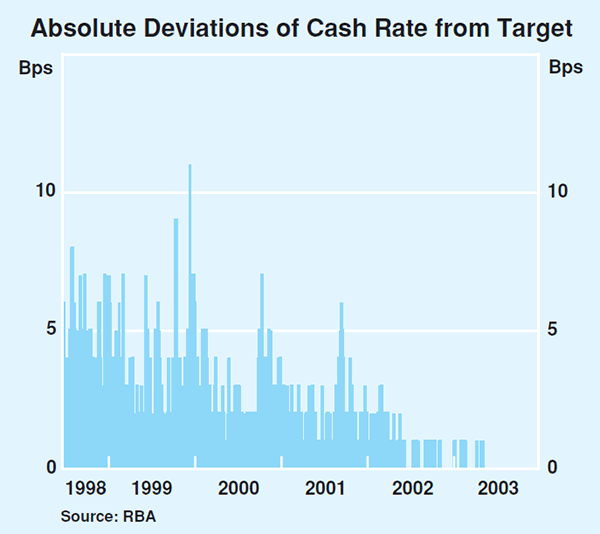
Since the beginning of 2001, the largest deviation of the cash rate from target has been an undershoot of 6 basis points. This occurred in the aftermath of the terrorist attacks in the United States on September 11 2001, when the Reserve Bank significantly increased the supply of ES balances to ensure adequate liquidity in the financial system as a safeguard in the uncertain circumstances of the time. Even accounting for this episode, deviations of the cash rate from the target in Australia are much smaller than similar deviations in many other countries.
The need to undertake operations on a daily basis to keep the cash rate near the target reflects the large day-to-day swings in the net flows between private financial institutions and the Reserve Bank. These swings arise largely from the Reserve Bank acting as the Commonwealth Government's banker, but also reflect transactions undertaken by the Reserve Bank's other clients (including overseas central banks), and by purchases and sales of currency notes by financial institutions as well as transactions undertaken by the Reserve Bank itself. If open market operations did not offset the resulting flows into and out of ES accounts, banks could find themselves flush with funds one day, but facing a shortage the next. The result would be a volatile cash rate.
While open market operations are needed to maintain the actual cash rate near the target, they are not needed to ‘move’ the actual cash rate to a new target rate. The expectation that the Reserve Bank will ensure that the cash rate is at the target is enough for the rate to shift immediately upon the announcement of a new target. By linking the interest rate paid on ES balances to the target cash rate, the effective cost of holding these balances does not change with changes in monetary policy. Reflecting this, there is no evidence of a relationship between the level of ES balances and the level of the target cash rate.
Open Market Operations
The Reserve Bank's open market operations are undertaken in repurchase agreements and outright transactions in short-dated Commonwealth Government securities (CGS).[3] When the Reserve Bank purchases securities, either outright or under a repurchase agreement, it pays for them by crediting the ES account of the seller (or its bank) and in so doing increases the supply of ES funds. Similarly, when securities are sold, the ES account of the buyer (or its bank) is debited, reducing the supply of ES funds. All transactions are for same-day settlement. By using short-dated instruments to conduct its operations, the Reserve Bank is able to limit the amount of interest-rate risk to which it is exposed.
Over recent years, the bulk of open market operations have been conducted in repurchase agreements (repos), rather than short-dated CGS. This reflects the greater liquidity of the repo market and the reduced supply of government securities on issue. In contrast, up until the early 1990s, open market operations were conducted largely in short-dated CGS. This shift has had a significant impact on the structure of the Reserve Bank's domestic portfolio (Graph 2).
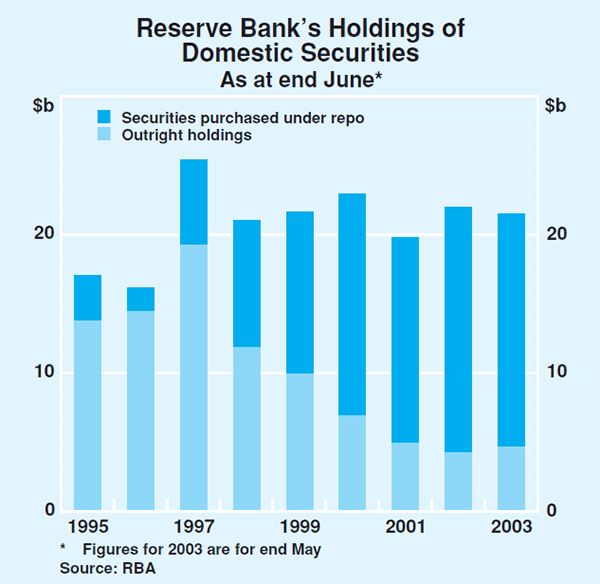
Until 1997, repurchase agreements were conducted in CGS only. In June 1997, the list of eligible securities was expanded to include domestic securities issued by the central borrowing authorities of the State and Territory governments. Certain AAA-rated domestic securities issued by supranational organisations were added to the list in October 2000. And in June 2001, A$-denominated securities issued offshore by the central borrowing authorities of the State and Territory governments were also added. Over the past few years, holdings of securities under repurchase agreements have been roughly evenly split between CGS and State and Territory government securities (Graph 3).
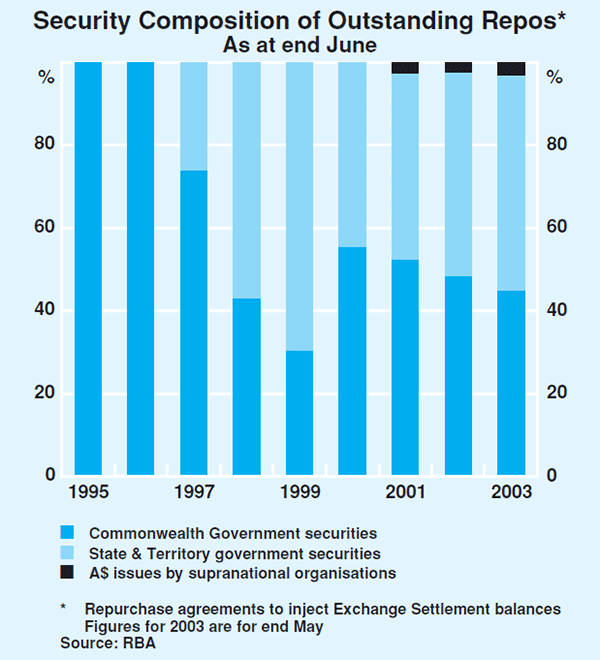
This widening of the list of eligible securities has been driven by a number of factors, including a decline in the value of CGS on issue, the increased demand for intra-day liquidity arising from the implementation of real-time gross settlement (RTGS) in mid 1998, and the larger intra-year swings in the flows between the Commonwealth Government and the private sector arising from changes to the tax system in July 2000.
On most days, the Reserve Bank's operations are injecting ES balances by buying securities under repurchase agreements. This reflects the fact that the system cash position – the projected change in settlement balances prior to open market operations – is typically negative. This is partly the result of the trend growth in the Reserve Bank's balance sheet due to the rise in currency on issue and, over recent years, an increase in the Commonwealth Government's deposits. It also reflects the use of repurchase agreements to conduct market operations, as the unwinding of previously conducted repos reduces ES balances (Graph 4).
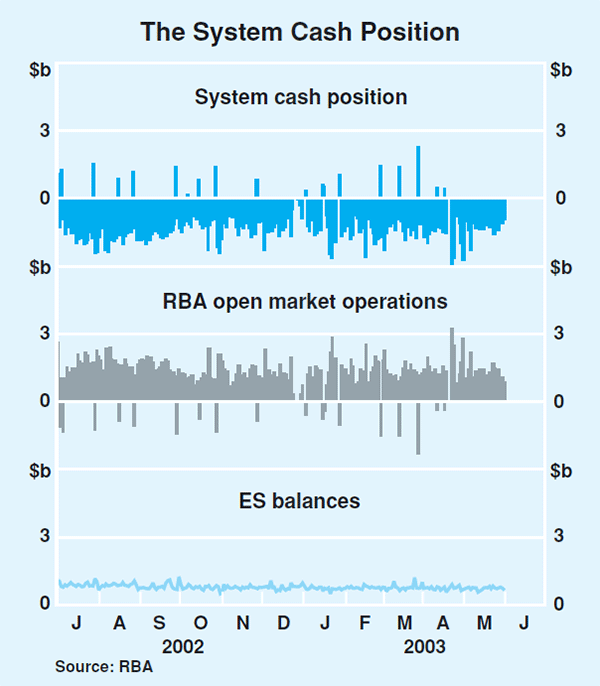
The main exceptions to this general pattern occur on public service pay days and days on which the Commonwealth Government transfers GST receipts to State and Territory governments that bank with private banks. On these days, the system cash position can be in surplus of $2 billion or more even after the unwinding of previously conducted repos is taken into account. To prevent a rise in ES balances on these days, the Reserve Bank sells securities under repurchase agreement from its own portfolio of CGS.
In the normal course, the system cash position determines the scale of open market operations undertaken on a given day. This approach ensures that, subject to unexpected movements, ES balances at the end of the day are around the same level as on the previous day. The value of transactions undertaken can, however, differ from that suggested by the system cash position. This might occur, for example, when the Reserve Bank wishes to supply extra liquidity, as was the case on September 12 2001, or accommodate a shift in demand for settlement balances by one or more account holders. The Reserve Bank has no prescribed target for the level of settlement balances, supplying whatever amount is needed to keep the cash rate near the target. Over the past year, balances have been around $750 million on most days (Graph 5). This is lower than the typical level of settlement balances in the late 1990s, reflecting the reduced demand for balances as account holders have become more used to the RTGS system.
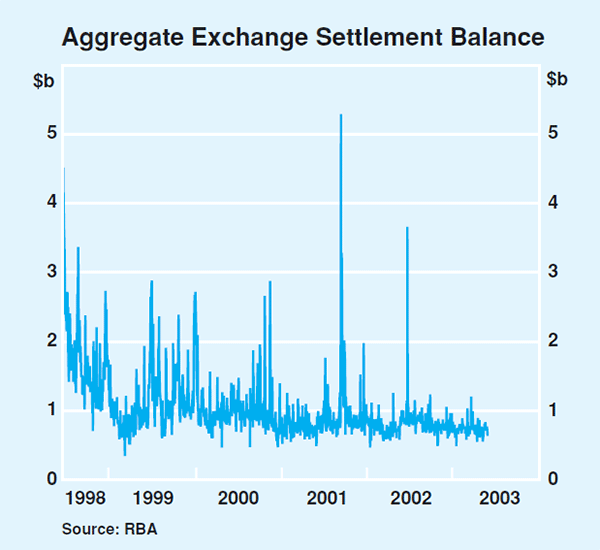
Approaches and allocation
At 9:30 am each day, the Reserve Bank publishes, via the electronic media, the system cash position for that day and whether it is intending to buy or sell securities. Since July 2002, it has also published its preferred maturities for repurchase agreements. In selecting the maturities of its repos, the Reserve Bank attempts to offset some of the expected future volatility in the system cash position.
On days when ES balances are being added, generally at least two preferred terms are announced, typically both under one month (Graph 6). Most weeks (normally on a Wednesday) longer terms of around 90 and 180 days are also offered, partly in an effort to facilitate the development of the repo market for these longer maturities. The introduction of the longer terms in mid 2002 has seen the average maturity of the Reserve Bank's outstanding repurchase agreements increase from less than 20 days to around 40–60 days (Graph 7). On days when ES balances are being withdrawn, only one term, of around 1 month, is normally announced. Although preference is given to bids and offers for repos of preferred terms, the Reserve Bank is prepared to consider approaches for other terms.
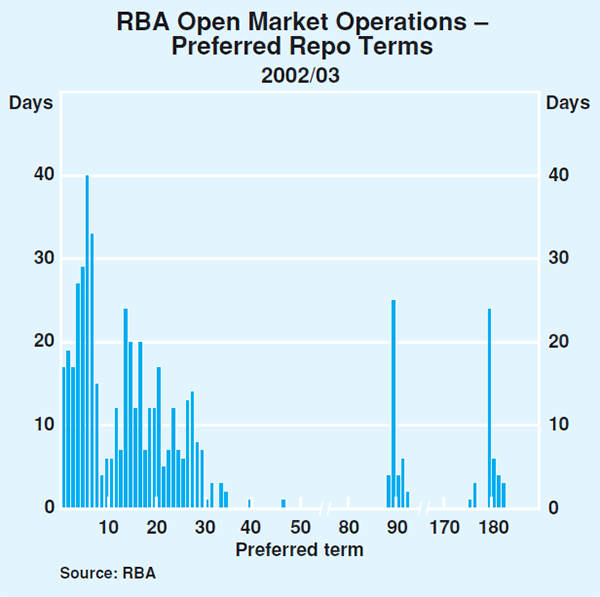

Market participants have from 9:30 am until 10:00 am to submit their bids/offers. Any institution which is a member of the electronic settlement system – Reserve Bank Information Transfer System (RITS) – is eligible to participate in open market operations. In practice, however, the bulk of transactions are undertaken with institutions that are active in the government bond market. These include the larger domestic banks, a few large non-bank financial institutions and local branches of some global banks.
Bids/offers for any given term are accepted in order of their competitiveness, and limits on individual counterparties are not applied. In allocating operations across maturities, the likely future system cash positions and the pricing of the bids/offers are both taken into account. The Reserve Bank does not commit to dealing at each of its preferred terms. Bids/offers for non-preferred terms and for short-dated CGS are evaluated in the same way as those for preferred terms.
The attractiveness of all bids and offers is assessed relative to market interest rates for each maturity – for example, as indicated by the overnight indexed swap (OIS) curve and pricing in the repo market itself. The use of market rates to evaluate bids/offers at different maturities ensures that the Reserve Bank's own views about the forward path of the target cash rate have no effect on the allocation process. There is no information content about the likely future course of monetary policy in the terms and rates that are accepted.
Second-round operations
In the normal course, open market operations are undertaken only once a day, although further rounds can be undertaken if warranted by conditions in the cash market. Since July 1998, a second round of operations has been conducted on only 13 occasions, all of which were to add additional ES balances (Graph 8). In most of these cases, the operation was in response to either a large unexpected payment to the Commonwealth Government which reduced aggregate ES balances or a temporary increase in demand for ES balances by one or more institutions. The largest second-round operation was on September 12 2001 and was in response to a sharp jump in the demand for liquidity as market participants became concerned about their ability to borrow funds in the market.
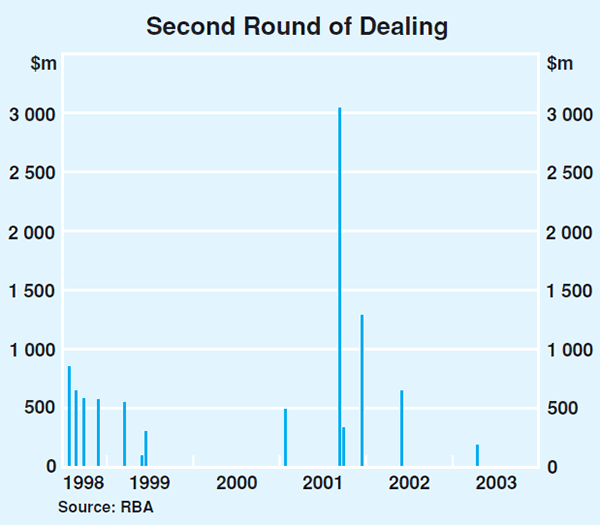
Second-round operations have normally been for an overnight term, although longer-term repurchase agreements have also been undertaken. The announcement, bidding and allocation processes work in the same way as for the morning operations.
Foreign exchange swaps
On occasions, open market operations in domestic securities are supplemented with foreign exchange swaps.[4] This is due to the combination of the trend growth in the Reserve Bank's balance sheet and the decline in the stock of government securities on issue. These developments have meant that, over recent years, the Reserve Bank has held a relatively large proportion of the government securities on issue, particularly around the time of seasonal peaks in its balance sheet. By undertaking foreign exchange swaps, rather than purchasing even more domestic securities, the Reserve Bank has been able to limit any distortions that its open market operations might have otherwise had on the domestic securities market.
Swaps may be undertaken for terms as short as one day, but are more typically undertaken for terms of around three months. On most occasions, they are planned in advance and undertaken for one- or two-day settlement and do not form part of the morning open market operations. Occasionally, however, the Reserve Bank may undertake a swap for same-day settlement when it cannot reasonably conduct operations of the desired scale based on the bids/offers that it has received for domestic securities. Over the past year, same-day swaps have been undertaken on just three occasions.
Given the growth in the Reserve Bank's balance sheet, most swaps are rolled over at maturity. One result of this is that the Reserve Bank's turnover in the swap market is significant and has been equivalent to around one-third of that in domestic securities over recent years. Occasionally, swaps are not rolled over and are instead used to smooth out large intra-year mismatches in the timing of the Commonwealth Government's receipts and payments. In particular, by allowing a swap that originally added liquidity to mature on a day on which liquidity needs to be withdrawn from the system, the Reserve Bank is able to reduce the swings in the system cash position.
Disclosure of Information on Open Market Operations
As noted above, the Reserve Bank has for some years been publishing the target cash rate and the system cash position each day at 9:30 am. The level of ES balances is published once a week as part of the publication of the Reserve Bank's balance sheet.
It has now been decided, after consultation with financial market participants, to increase the range of information published regarding open market operations. In particular the following information will now be made available:
- the total value of open market operations;
- the weighted average rate, the cut-off rate, and the value of all repurchase agreements, by term;
- the value of all outright transactions in short-dated CGS; and
- the value of same-day foreign exchange swaps.
This information will be released by electronic media at around 10:45 am. The 9:30 am release will also be expanded to carry the previous day's aggregate end-of-day ES balance.
This information will also be posted on the Reserve Bank's website, through which users will be able to access historical data. A new Bulletin table (Table A.3) is also being introduced with this issue of the Bulletin. This table will contain a summary of the above information, as well as details on the type of securities bought/sold under repurchase agreement by the Reserve Bank.
Footnotes
For previous articles on open market operations, see F Campbell, ‘Reserve Bank Domestic Operations Under RTGS’, Reserve Bank of Australia Bulletin, November 1998, available at <http://www.rba.gov.au/publications/bulletin/1998/nov/pdf/bu-1198-3.pdf> and ‘The Reserve Bank's Domestic Market Operations’, Reserve Bank of Australia Bulletin, December 1990, available at <http://www.rba.gov.au/publications/bulletin/1990/dec/pdf/bu-1290-2.pdf>. [1]
Currently, 17 banks participate in the survey, which together account for around 85 per cent of total real-time gross settlement (RTGS) transactions. [2]
When conducting a repurchase agreement, the Reserve Bank buys (sells) a security at its current market price and simultaneously agrees to sell (buy) the security back to the same counterparty at an agreed price at a specified future date. In outright transactions, there is no agreed reverse transaction. [3]
To inject ES balances through a swap, the Bank buys foreign exchange, paying for it by crediting the ES account of its counterparty, or its bank, with Australian dollars. Under the swap the transaction is reversed at an agreed rate at a specified point in the future. As such, the swap is similar to a repurchase agreement in domestic securities, the only difference being that the Australian dollars are exchanged for foreign currency rather than domestic securities. Foreign exchange swaps do not involve any foreign exchange risk and have no effect on the exchange rate. [4]